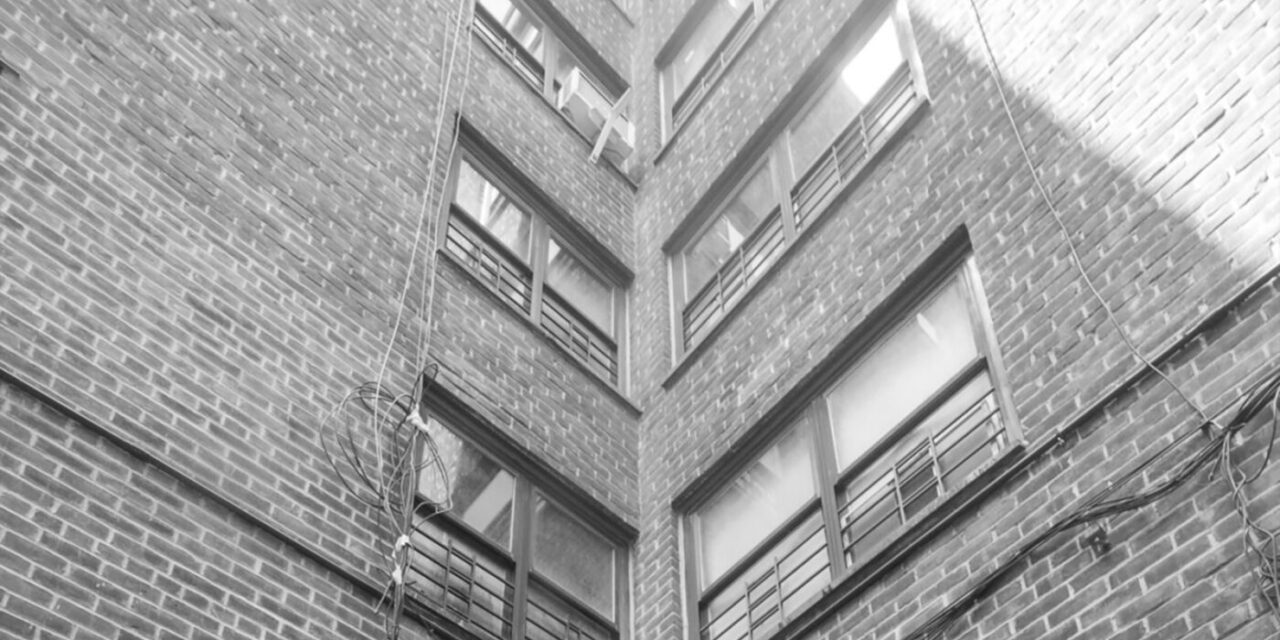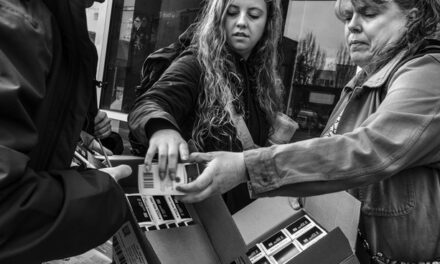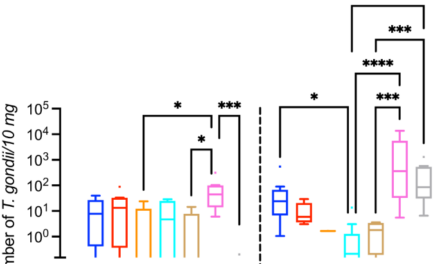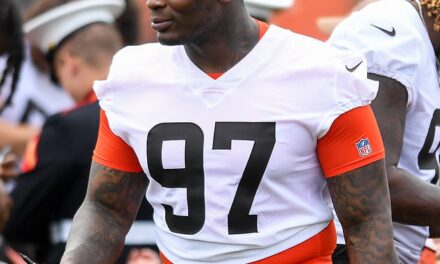
Cover of H31R (maassai and JWords), HeadSpace, 2023.
maassai’s musical projects are carefully curated, as evident most notably in C0n$Truct!0N . . . (2019) and C0n$Truct!0N 002: The Caution Tape (2020). The tracks on these releases encompass complex meditations on space: taking up space as a means of representation, displacement from spaces because of gentrification, and metaphorically escaping into outer space as a vehicle for spiritual advancement. Having grown up in the Brooklyn neighborhoods of Brownsville and East New York, maassai considers herself part of the “hood avant-garde,” a term she uses to emphasize the expansive and multifaceted creativity coming out of often economically disenfranchised Black communities. Recently, in addition to performing solo and with producer JWords as part of H31R, which has just released their second full-length project, HeadSpace, she has begun creating performance and visual art, evincing an increasingly historical outlook in pieces like Dark Matter & the Beast (2022/2023), which poetically chronicles the haunting precipitated by the intentional destruction of Black townships and the ongoing trauma of the Middle Passage. I spoke with maassai about the ongoing evolution of both her music and her art.
—Branden W. Joseph
Branden W. Joseph Your music is very personal, but you’re also a real social observer. How do you think about that balance?
maassai That’s a really good question. They’re both so integral to each other. I call myself an extroverted introvert. I’m really into observing social situations, going out and exploring the world but from this insider point of view. I think that carries over to what I have to say in my music. It’s coming from the perspective of a person who’s kind of a loner in a lot of ways, but who also likes to be out in the world observing and finding gems that I can take back and use as momentum for growth personally. So, yeah, I think that’s definitely reflected in my music a lot.
BWJ How did you develop your musical voice, which veers from almost steely rap to neo neo-soul stylization?
mI grew up singing in church, and I also grew up in hip-hop culture, so I had these almost contradictory worlds in my environment growing up. One thing that I’ve noticed about femmes and women who rap is that people tend to take away their credibility if they also sing. When I started rapping, I was worried about adding singing to the mix because I didn’t want that credibility being taken away; but the older I grow, the more I’ll lean into it. That’s probably what you’ve noticed.
BWJ Tell me about your recent artworks, The per-Sonal Year Eight Performance livestream (2022) and Dark Matter & the Beast: Black Being from the Future Gives Birth to America in Our Past, which was performed live at Montez Press Radio in 2022 and livestreamed in a different version on Bandcamp this past February.
mThe livestream idea came from the pandemic, honestly. Bandcamp opened up this portal to livestream, and I threw a release show for With the Shifts (2021), my first full-length album. I gathered people on the bill in a studio called the Raga Closet, which was a thrift store that my friends have. The per-Sonal Year Eight was an experiment. I took a bunch of video archives that I had in my possession, and I did research and put DIY music sets together in my house to create this historic memoir about wealth and creativity based on my family, who are also artists. This practice has been really fun because it’s allowed me to do everything that I like in this concentrated period of time. I’m able to do performance, art, music, and fashion and research, which is something that I really care about—all these things incorporated.
BWJ Per-Sonal seems to be about your family’s relationship to diaspora. Dark Matter seems more research-based, with a Nikki Giovanni poem, archival footage of Civil Rights leaders, a W. E. B. Du Bois quote, and information about the intentional flooding of Black townships. How did you develop from one to the other?
mI would say that they were both, at least from my perspective, very much research-based. Exploring that history within my family, I went through my grandfather’s archives. Some of the people in that piece weren’t related to me but provided context about the places that my family came from, which is Panama by way of Jamaica and Georgia. I was inspired by that to research more for Dark Matter & the Beast. The Montez Press iteration was an audio play. I had a three-piece band, and I was the narrator, and we told the story through music. There were no theatrics. We had some visuals on the wall, but it was a story you could really follow like an audio play. I was using “dark matter” as a way of relating Blackness to futurism, and space, and, like, otherworldliness. That’s kind of my schtick. It was about this futuristic Black being that time-travels to the Middle Passage era and gives birth to America, and then is trying to find their way back home to that utopia, that future, but gets stuck in different parts of our collective memory as Black people.
BWJ In Dark Matter, you come on screen looking like Sun Ra. What’s your relationship to Afro-Futurism?
m Anybody who knows me knows I love the space shit. I’m into it. I love sci-fi, specifically technology-based futurism. And I’m really interested in placing Black people who come from the hood in sci-fi environments because I believe that the otherworldliness of the culture is just so fitting, honestly. I’m definitely inspired by people like Sun Ra, Alice Coltrane, and a lot of other ancestors who have pushed those Black futurist ideas. I really would love to see more sci-fi in the context of people coming from where I come from and being able to see themselves in that way. That’s a large part of my work.
BWJ The metaphor of water also connects your music and your art. On “The Shifts,” for instance, water metaphorically indicates adaptation and resistance.
m I talk about water a lot because I talk about fluidity a lot. But when I was researching Dark Matter & the Beast, I came across all of these historical Black towns that had been purposely flooded and erased, basically, in the creation of man-made lakes. I was like, What? They were drowning Black cities? It’s not that surprising, but it’s also interesting that water has been so stigmatized in the Black community. As I mention in Dark Matter, they say that Black people don’t swim because of the ancestral trauma of the Middle Passage, and then to find out that our cities were flooded! To take that further, the horror/sci-fi element is that so many people actually end up dying in those lakes now because there’s still remnants of the actual cities floating in the water. They didn’t even bother taking it out; they just flooded it, so it causes boats to bump into things. It’s not a safe environment.
BWJ Is that why you say, “monsters that lurk in the waters where these towns used to be”?
m Yeah, exactly. And people do say that, like, Lake Lanier in Georgia is haunted because of it. There’s a lot of people who’ve died in those lakes.
BWJ The discussion of submerged Black towns gives a wider historical dimension to the discussion of gentrification initiated in C0n$Truct!0N. In a performance I saw, you had a line about people looking like new construction. What was that?
m It’s a storytelling song. I’m listing out my whole day from the wake up, and I’m talking about this train ride where I see someone who is obviously a gentrifier to my neighborhood. I think I said she has hipster vibes or something like that, and, “She looked at me and made a smile that could light up this whole town, just like the buildings they are building all around.” That song is really about connecting my experiences walking through the world, where everything is kind of a metaphor for another thing, or everything is a reflection of each of our experiences as we’re walking through the world.

maassai portrays an omnipotent Black being who exists in the past, present, and future.
BWJ I want to tease out the specificity of your idea of the “hood avant-garde.” As I understand it, it’s not simply about the creativity coming out of Black communities. It’s about a connection to place and the lived experience of such communities, but it’s also about expanding or transgressing expectations about them.
m That’s definitely correct. It’s about the innovation that comes from our community, specifically because we have to be resourceful. Lack of resources makes for innovation because you have to figure out how to do it. You have to make something out of nothing. I think that’s why these communities are the driving force of creativity in general. You have to be creative. There’s no choice but to be creative. Further than that, I really want to drive the point home that there isn’t this monolithic view of what it looks like to be a Black person from the hood. I get emotional every time that I’m talking about it because I feel like there is ignorance out there about the Black community and specifically the hood: that it’s all violence, all ignorance. But we are so expansive in who we are as people. I often reference Du Bois’s idea of “double consciousness” because I think it’s accurate in terms of the fact that, as Black people walking through this world, we have to not only understand ourselves and our predicament but also have to be very aware of the powers that be. Living in those two worlds at the same time automatically makes for a multidimensional person.
BWJ It also, it seems to me, speaks to the experimentalism of the particular musical scene that you’re part of.
m Yeah, for sure.
BWJ So when you say on “Grace Jones” that you’re trying to “exit” and “make that move,” you’re not talking about leaving the community; you’re talking about transforming the culture.
m It’s about this idea of expanding into everything we are in that multidimensional nature of being, expanding into all of our potential. That’s my goal for myself; and as a Black person from Brownsville, I would hope that for the rest of my community as well. As a person from here, I know how creative we can be. I know how innovative we are. Imagine if we actually had the resources in our neighborhoods to support the expansion. That’s why in 2017, Amani, Iman Essiet, and I developed HouseFire, a community creative resource in East New York, very close to Brownsville. I grew up in both of those neighborhoods, so that was very important for me to have the opportunity for people from that neighborhood to experience the arts and be a part of it.
BWJ Can you talk about your interest in curating, which you’ve beautifully described as “holding space for art”?
m I’m just as passionate about curating as I am about making art. It might sometimes be even more important because holding space and having the opportunity for community to be together and experience whatever transformative art is present is so important. That’s the way that we use art to organize our communities—by actually experiencing it together and having space for people to be inspired. I have a curatorial platform called Shiny Shit that is specifically about this whole hood avant-garde idea. I’m really interested in thinking of new, innovative ways to create space. I’ve done an experimental game night, which was about introspection. We’ve also done live music shows as well as conversations. I’m thinking of different ways to have events that aren’t just you come to a live show and you see this bill. I’m looking to really get it rolling this year. Throughout the pandemic, it’s been like, “maassai,” but my mind is coming back to community.
HeadSpace is available here.




